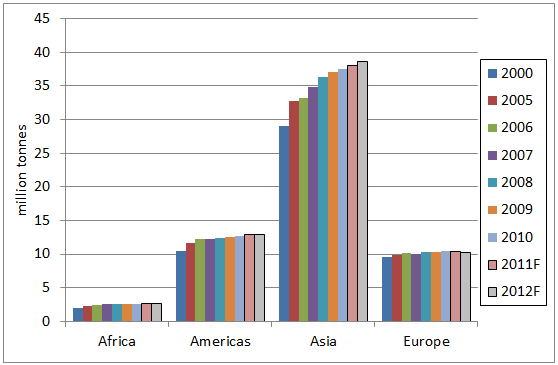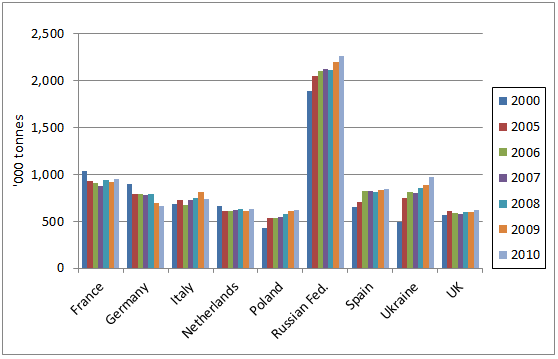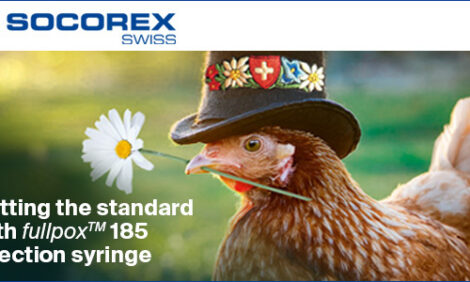



GLOBAL POULTRY TRENDS 2011 - EU’s Share of European Egg Total in Decline
The European Union’s contribution to total European egg production in the decade 2000 to 2010 contracted from 70 per cent to almost 64 per cent, writes seasoned industry watcher, Terry Evans, in his latest review of the trends in the European egg market.Looking ahead to the end of 2012, it seems that the ban on conventional layer cages, which still has yet to be fully implemented in several member states, will result in a reduction in production and a further decline in the share of EU output in the total for Europe. With production sure to contract in several EU countries, the total for the EU will fall short of the average for the five years to 2010 of 6.7 million tonnes.
For Europe as a whole, egg production expanded by around one per cent annually between 2000 and 2010 as annual output climbed from 9.5 million tonnes to 10.5 million tonnes (table 1). However, for the EU, the expansion rate was a negligible 0.2 per cent per year, which contrasts starkly with 2.7 per cent for the rest of Europe and also a global growth average of 2.2 per cent (table 2).
In terms of numbers of layers, the EU looks to have around 480 million hens out of a European total of almost 790 million and a world figure of 6,500 million.
European egg processors have the capability of producing two million tonnes of egg products a year although their actual output is likely to be less than this.
Looking ahead, global shell egg production (including hatching eggs) output this year could come close to 65 million tonnes. As it is likely that a cut–back in the EU will not be fully offset by further growth in Russia and the Ukraine, Europe’s contribution to the world total at around 10.2 million tonnes looks likely to fall short of the peak level of 10.5 million tonnes achieved two years ago (table 1 and chart 1).
The nine largest egg industries in Europe, each producing more than 500,000 tonnes a year (Table 3 and Figure 2) accounted for 8.3 million tonnes in 2010 or nearly 80 per cent of the regional total.
Table 2 shows just that most countries produced fewer eggs in 2010 than in 2000. Indeed, the only ones to record significant continuous growth throughout the decade were the Russian Federation, the Ukraine and Poland. While the United Kingdom produced 88 per cent more eggs in 2010 than in 2000, the increase has been a mere 10,000 tonnes since 2005.

Russia is by far and away the leading producer, accounting for more than a fifth of the regional total. According to FAO data in 2010, there were nearly 156 million layers in Russia. Egg output was put at 40.4 billion, of which three–quarters came from commercial companies. All short–term forecasts point to continued expansion in production, reflecting further increases in sales to both the retail and industrial sectors. In recent years, Russia’s industry has been expanding at around three to four per cent per cent a year, which would point to a 2015 total of some 2.7 million tonnes. However, one forecast considers that, by 2015, egg sales will not amount to more than 44.6 billion, equivalent to around 2.5 million tonnes. Furthermore, Russia’s Ministry of Economic Development considers that growth will not be dramatic and total output in 2014 may be only 2.5 per cent above the 2010 figure, which would be less than 2.4 million tonnes. The bulk of production comes from just three regions, 24 per cent from the Volga Federal District, with the Central Federal District accounting for a further 19 per cent and the South Federal District some 14 per cent.
Because of its size in relation to the rest of Europe, much attention is focused on developments in Russia. However, the fastest growing egg industry in the region is in the Ukraine. Here, between 2000 and 2010, output expanded from less than 500,000 tonnes to nearly one million tonnes, equivalent to an average annual growth rate of nearly seven per cent. In 2011, egg production is reported to have increased by a massive near 10 per cent to almost 1.1 million tonnes.
Ukraine's largest egg producer, AvangardCo, has almost 25 million layers capable of producing 6.8 billion eggs. In 2011, this company produced almost six billion eggs, which represented around one–third of all the country's eggs although it maintains that it produces some 43 per cent of what it considered to be ‘industrial’ production. It also claims to account for 74 per cent of the country’s output of dried eggs, 97 per cent of all dried egg exports and 52 per cent of shell egg exports. For AvangardCo, the most rapidly growing export markets are Iraq and the Commonwealth of Independent States, these accounting for 60 per cent and 38 per cent of its business, respectively, in 2011. This company has also opened up new markets in Armenia, Turkmenistan and Azerbaijan.
Throughout the past decade, annual egg production in the European Union has hardly changed fluctuating between 6.6 and 6.8 million tonnes. Currently, the egg industries in the Community are in crisis as earlier this year, it was claimed that producers in many of the 27 member countries had failed to conform to the ban on conventional battery cages, which came into effect on 1 January 2012. They were: Belgium, Bulgaria, Cyprus, France, Greece, Hungary, Italy, Latvia, the Netherlands, Malta, Poland, Portugal, Romania and Spain.
The resultant possible culling of layers and the time lag involved in switching to less intensive production systems will guarantee that egg production in the Community will fail to reach recent levels. Indeed, it is considered that the shortfall could be somewhere between 15 and 20 per cent. To some extent this cut–back will be offset by gains in European countries outside the Community and in particular, Russia and the Ukraine. Nevertheless, it looks as though the total for Europe will contract from the peak of 10.5 million tonnes achieved in 2010 to around 10.2 million tonnes in 2012.
Of the 6.7 million tonnes of eggs produced in the EU, about 1.8 million tonnes or 27 per cent are used by processors for the production of egg products. There are just over 100 processing plants in the EU, and according to Filiep Van Bostraeten, CEO of Ovobel Ltd, the proportion of eggs processed could rise to between 30 and 35 per cent by 2015. Some product users in the food industry are only using non-cage eggs to help boost the animal welfare–friendly image of their business and branded products.
The investment required to make the switch from conventional cages is substantial. The increased cost of egg production is expected to range between seven and 12 per cent in general although in some instances, it could be as much as 20 per cent or more. Indeed, one calculation reveals that the cost of getting out of conventional cages when combined with other EU costs such as the GMO ban, environmental restrictions on manure and house emissions, higher labour and energy costs, egg production in the EU could eventually cost 50 per cent more than in countries like the US and Brazil.

Egg production (table and hatching) in France has failed to match the peak of more than one million tonnes achieved in 2000 and 2001. The quantity of table eggs produced amounted to 825,000 tonnes in 2009 and 875,000 tonnes in 2010. The proportion produced in enriched cages or in barn, free–range or organic systems was only 40 per cent in 2010. Output looks likely to contract this year as the conventional cage flocks are depleted. More than 96 per cent of eggs are brown–shelled.
The proportion of processed eggs consumed in France was around 25 per cent in 2010 and this figure is likely to increase to around 30 per cent or so in the near future. But the key question is, what quantity of product will be produced from French eggs and how much will be imported from third countries?
Egg production in Germany has contracted dramatically since 2000 from more than 900,000 tonnes to less than 650,000 tonnes in 2010. According to the Germany representative at the International Egg Commission (IEC), the quantity of table eggs produced in 2010 was less than 600,000 tonnes. This country introduced a total ban on conventional cages in 2010, since when it has seen its level of self–sufficiency fall to just 55 per cent. Currently, around 63 per cent of eggs come from barn systems, 19 per cent from free–range and 18 per cent from enriched cages. Germany is the world's biggest importer of shell eggs, the quantity exceeding 500,000 tonnes in 2010.
Developments in other EU countries as they conform to the cage ban could impact on production in Germany but, at present, it seems unlikely that the industry will change greatly in the foreseeable future. Indeed, there is a view that German egg producers are well placed to take advantage of a growing demand for non–cage eggs elsewhere in the Community.
The egg industry of Italy expanded in the period 2000 to 2009 but then contracted in 2010. At that time, still more than half of the flock was housed in conventional cages. While it is still unclear what actions will be taken by individual governments in the EU over the production of eggs now considered to be illegal, it is hard to see how the Italian industry would not contract, at least in the short-term. All bar seven per cent of Italy’s eggs are brown–shelled.
An upward trend is evident in the production of eggs in Poland (tables 2 and 4). The Polish industry had asked for an extension of the ban on conventional cages but the European Commission refused the request. Lack of finance will almost certainly mean that some producers will not have conformed to the regulation, hence the upward trend in production could now be reversed. Indeed, the Czech Republic has recently banned Polish egg imports because of the latter’s failure to conform to the EU hen welfare regulations. Just 10 per cent of eggs are not brown.
According to the country’s representative at the IEC’s annual conference, 2010 witnessed a five per cent cut–back in table egg production in Spain to just less than 770,000 tonnes. Many farmers have failed to comply with the hen welfare regulations and although they have recently asked for derogation for two years, the Commission is unlikely to agree. Hence, some producers will be forced out of business bringing about a further cutback in output. Some 90 per cent of eggs are brown–shelled.
Both the Netherlands and the UK claim that their egg producers have conformed to the new regulations.
As a result of the move away from conventional cages, production costs have risen. Regardless of member country, those producers who have invested significant sums to conform to the new legislation are, naturally, greatly concerned that their markets may be exposed to supplies from producers who have failed to make the required changes. While this is most unlikely in shell form, the worry is that these cheaper eggs will find a way into the products sector. In the UK, several users of egg products have given an undertaking not to use products from eggs produced in conventional cages.
April 2012












